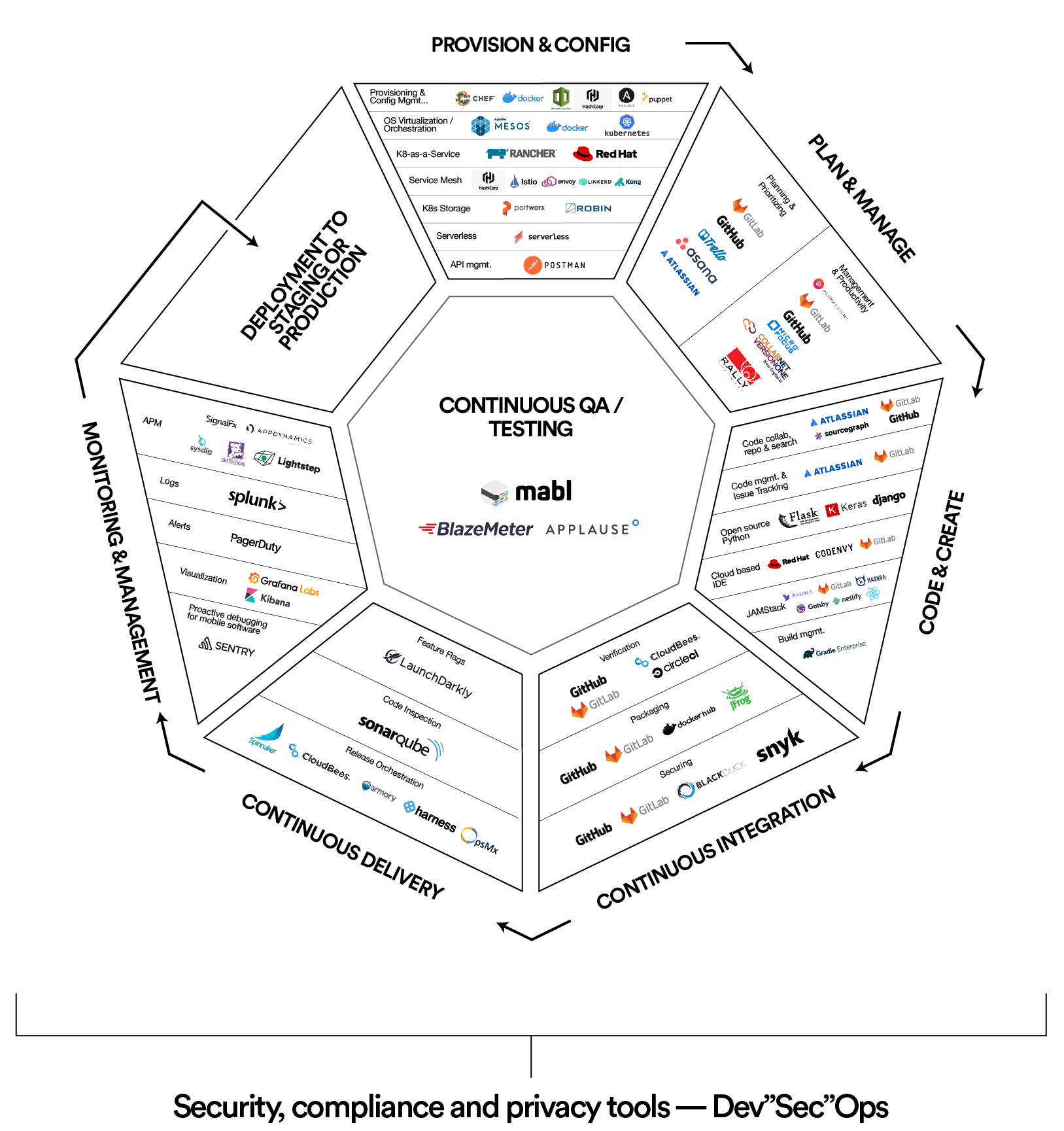The DevOps Landscape: Past, Present, and Future
May 12, 2020
Steve Vassallo
The enterprise stack is constantly evolving—cycling from simplicity to complexity and back again—until, every few years, it is utterly transformed. In the enterprise stack’s current form, IT and developer functions have converged, laying the foundation for present-day DevOps. However, the speed at which these changes have occurred has created a fundamental challenge: the absence of all-purpose DevOps engineers.
Even if a company has access to these developers, their time and abilities are scarce resources that have to be allocated smartly. The best way to do so is by having them use enabling infrastructure tools from external vendors. This allows these critical engineers to prioritize core functions like writing code and developing applications. In addition, they can take advantage of open source tools, of which Big Tech enterprises have been both pioneers (Spinnaker from Netflix; Jaeger from Uber; Kubernetes from Google) and beneficiaries (IBM acquired RedHat; Microsoft acquired GitHub).
At Foundation Capital, we believe this space is fertile ground on which startups can innovate. We’ve already made eight investments in infrastructure, including Cohesity, Mesosphere (now D2iQ), Cliqr (acquired by Cisco), OpsMX, and Robin Systems. In this blog post, we sketch out opportunities for startups to help enterprises boost developer productivity, increase software deployment velocity, and increase market share.
The DevOps Landscape:
The way we visualize the DevOps market is as a seven-stage workflow: 1) Provisioning and Configure → 2) Plan and Manage → 3) Code and Create → 4) Continuously Integrate → 5) Continuously Deliver → 6) Monitor and Manage → 7) Deploy to Staging or Production. An additional process, Continuously QA/Test, happens throughout the DevOps workflow. (Note: We are excluding, for later analysis, a related but separate discussion about security, compliance, and privacy.)
With the advent of DevOps, certain stakeholders have taken ownership over certain parts of the workflow. Understanding the daily responsibilities of these stakeholders is important for building products that address their unmet needs and specific go-to-market strategies. The four stakeholder personas are: Software Developers; Release Managers (or IT Ops); Infra Architects, SREs & System Administrators (or IT Ops); and Security Engineers. And here is where they fit in the DevOps landscape:

Hopefully, the above will provide a useful roadmap for entrepreneurs trying to discern the best problems to try to solve and opportunities to chase.
DevOps Investment Opportunities
From the work that we’ve done in the space, we believe there are six promising investment opportunities in DevOps:
- Automate workflows by connecting tools across DevSecOps lifecycle: We are excited for the potential of automating the DevOps assembly line by combining disparate tooling across Provisioning & Configuration, CI/CD, APM to Security, and Incident Management. Besides the tremendous activity in the landscape, the automation approach can harness the comprehensive toolset from public-cloud providers and/or the open-source ecosystem in the category.
- Identify opportunities in next-gen Monitoring & Management: Beyond the opportunities outlined in our previous blog post on next-gen APM, these are some additional emerging opportunities in the category:
- While most APM tools focus on backend systems, end-user API monitoring can surface potential issues timely
- With a surge in infrastructure and application data, there is a need to reverse the “forensic debugging” paradigm by extracting real-time insights from data (e.g., transforming observability data in motion)
- In spite of the explosive growth in both quantity and capability of connected devices, there remains a massive gap with respect to application and network performance tools for embedded devices
- Focus on continuous testing tools to keep pace with the agile DevOps workflow: The current CI, CD, or staging environments have their ad-hoc unit tests, fuzz tests, or chaos engineering tests. However, modern testing needs to become continuous and provide a single-pane-of-glass view into the health of the overall application stack, related service dependencies, and bottlenecks—not just the resilience of particular components of the application.
- Invest in assessing developer productivity: While sales and marketing teams have clear productivity metrics, engineering teams still lack clear productivity metrics. Today, engineering teams are stretched between developing new features, fixing bugs, and managing infra requirements—all while ensuring security and reliability. With so many moving parts, it is hard to assess if engineering effort aligns with key business objectives. One of the early pioneers in the category was Gitprime, which was acquired by Pluralsight. We believe a next-gen solution in this category won’t just provide better visibility and productivity assessment, but also meet developers in their workflow to automate repetitive tasks and minimize dependencies.
- Infuse a resilience-first approach in product development: With a growing need to release better features faster, Site Reliability Engineering (SRE) is becoming an integral discipline adjacent, and complementary, to DevOps. Though SREs focus primarily on managing production incidents, we believe there is huge potential to build resilience to failure in software development through proactive reliability measures (e.g., chaos engineering).
- Nurture the API-first culture and Support the JAMstack community: Backend developer bandwidth creates a bottleneck for the fifteen million frontend developers who are familiar with ReactJS, Java, and GraphQL, and have access to over twenty thousand publicly accessible APIs to launch websites. We are excited to support this community through opportunities in GraphQL enablement, next-gen CMS, API integration workflows, or low-code/no-code web development platforms (e.g., web flow).
At Foundation Capital, we are always looking to partner with early stage founders who are passionate about addressing developer challenges and are looking to build category-defining DevOps companies. If you are building a next-generation developer-focused product, we would love to hear from you.
